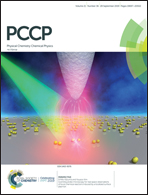Forces between zinc sulphide surfaces; amplification of the hydrophobic attraction by surface charge†
Abstract
Smooth Zinc Sulphide (ZnS) surfaces were prepared by magnetron sputtering and the interaction forces were measured between them as a function of pH. At the isoelectric point (iep) of pH 7.1 the attractive force was well described by the van der Waals interaction calculated using Lifshitz theory for a layered system. Away from the iep, the forces were fitted using DLVO theory extended to account for surface roughness. At pH 9.8 the surfaces acquire a negative charge and an electrostatic repulsion is evident. Below the iep the surfaces acquire a positive charge leading to electrostatic repulsion. The forces in the range 3.8 < pH < 4.8 show an additional attraction on approach and much greater adhesion than at other pH values. This is attributed to the hydrophobic attraction being amplified by a small degree of charge on the surface as has previously been reported for adhesion measurements. The range of the measured forces is attributed to the long-range orientational order of water (>5 nm).



 Please wait while we load your content...
Please wait while we load your content...